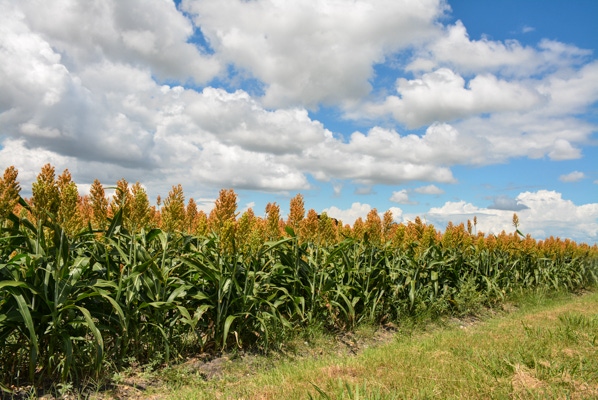
Sugarcane aphids have been found in sorghum recently in 10 counties from Kiowa County north to Grant County, but none have been reported at treatable levels.
“Oklahoma is seeing the benefit of producers taking appropriate steps several years ago when the problem with sugarcane aphids jumping crops initially hit the state,” said Tom Royer, Oklahoma State University Cooperative Extension Integrated Pest Management coordinator.
Royer led the team of OSU entomologists who played a pivotal role in conducting the science behind the research-based recommendations that helped producers solve many of their issues relative to the aphid incursion. Best management practices and planting sorghum varieties that had greater resistance to aphids were among the recommendations producers took to heart.
However, Royer stressed while treatment is not currently necessary and likely cost-prohibitive given the time of the year, producers still need to be scouting their sorghum fields.
“If the aphids reach sufficient numbers where they get up into the heads they could cause issues during harvest,” he said. “It’s not likely that will be the case but it’s best to make sure ahead of time so the producer can plan accordingly. Think of scouting as a risk management tool, an operational investment in time, energy and effort that can save dollars down the road.”
Scouting made easy
To scout, a producer should start at the edge of a field and take both an upper and lower leaf of a plant. Look at both simultaneously and determine whether or not both of them combined have 50 aphids or more, or less than 50 aphids. Examine three plants in a row. Take about five steps and repeat the process.
“From there, take about 20 steps before examining the next set of three plants in a row, repeating the process across the entire sampling area,” said Jessica Lindenmayer, graduate researcher with OSU’s department of entomology and plant pathology. “A producer can use his or her own judgment as to how far into the field one goes, but we recommend using an inverted ‘U’ shape when walking and sampling.”
In other words, pick an edge as a starting point, work your way into the field and then wind around and eventually exit at another edge, sampling periodically along the way.
“The sampling technique allows a producer to work so fast that he or she can quickly make a treatment decision based on 18 to 20 samples or less, per field,” Lindenmayer said. “Typically this is all that is needed to determine if the aphids are at or above treatable levels in the field.”
Sampling sheets – one designed for Oklahoma, Kansas and northern Texas with another being released later this fall for southern Texas, Arkansas and Louisiana – have been developed by OSU and cooperating partner institutions. The northern tier sampling sheet is available online at http://www.oces.okstate.edu/sorghum-aphids. Simply follow the directions listed.
“We designed it for ease of use,” Lindenmayer said. “Seriously, it’s extremely easy to use, between three and five minutes for most people.”
As the lead developer of the sampling sheet, Lindenmayer stressed producers should always use it when using the new, recommended sampling protocol. If not, producers need to use the previously recommended sampling method of taking 54 plant samples and determining if more than 20 percent are infested with more than 100 sugarcane aphids. “Sampling in the field is the only way to make an informed decision,” she said.
Cooperation amongst five states
Royer and Lindenmayer are part of a multi-institutional team working on sampling sugarcane aphids across five states: Oklahoma, Kansas, Texas, Louisiana and Arkansas, with Mississippi taking part for a year as well. Participating scientists developed a grid system for fields and discovered just how sugarcane aphids colonize an area.
“From there, we developed the user-friendly, research-based sampling protocol,” Lindenmayer said. “This is because it quickly becomes evident where the aphids are present and allows a producer to quantify them and make a treatment decision in a rapid manner,” Royer added the goal of the sampling protocol is not to necessarily determine how many aphids might be infesting a field but rather whether or not a field’s treatment threshold has been reached.
“That’s really what a producer wants to know, is it time to treat or not?” he said.
The multi-institutional team approach has paid significant dividends in helping agricultural producers throughout the five-state region effectively address the sugarcane aphid incursion.
“It was evident early on as the aphids moved from south to north that we needed to help producers throughout the region get control of the situation,” Lindenmayer said. “It’s a major reason why we plant sorghum varieties that are more susceptible to sugarcane aphids than those we recommend for sorghum growers. To do the research, we need to see bad situations as well as the good.”
The Oklahoma Cooperative Extension Service is one of two state agencies administered by OSU’s Division of Agricultural Sciences and Natural Resources, and is a key part of the university’s state and federally mandated teaching, research and Extension land-grant mission. The OSU department of entomology and plant pathology also is part of DASNR.
About the Author(s)
You May Also Like




